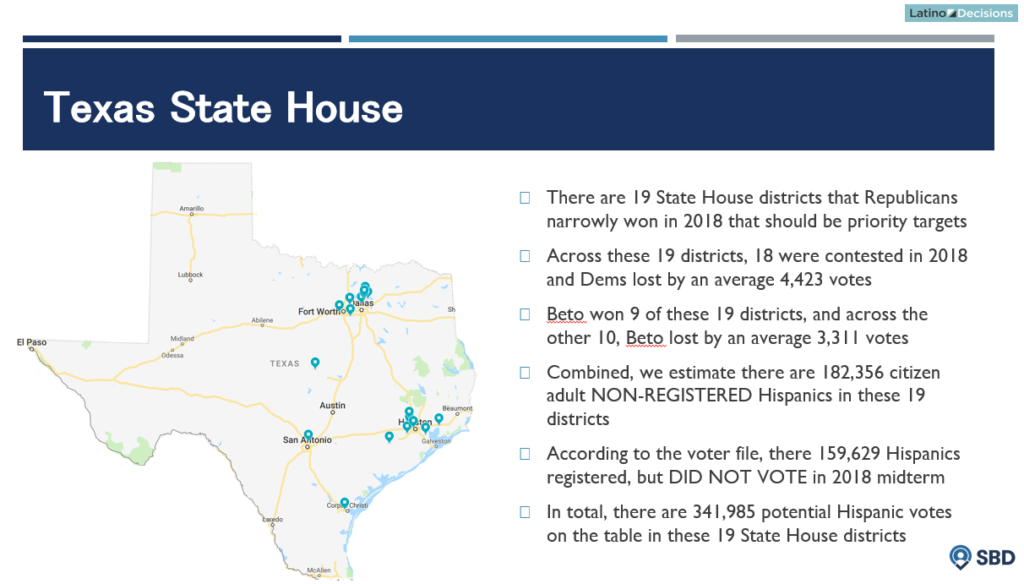Think nationally, act locally. It’s a lesson all smart parties heed. Despite the inordinate attention paid to congressional and especially presidential elections, capturing and maintaining control of state legislatures matters a lot. In that spirit, I continue my efforts to analyze partisan trends in Texas—surely now more timely than ever, coming on the heels of the Trump’s recent campaign event in Dallas.
The Lone Star Alignment
My previous post focused on whether Texas should be considered competitive in next year’s presidential contest. What Trump’s team sees in their internal numbers must mirror public polling, which should worry them: According to Real Clear Politics’ average, the president trails Vice President Joe Biden by 3 points in Texas.
Historically, the time a president dedicates to campaigning a full year before an election is minimal. Presidents typically try to pass signature legislation. Needless to say, Trump’s constant visits to Texas tell us all we need to know: He’s nervous, which means the Lone Star State is in play for the first time in decades. And not just in statewide elections but in state legislative races, too.
Same story, different legislative battle
I promise to return my attentions to the White House, but this week I shift my focus to the Texas state legislature. Cutting to the chase, the pick-up opportunities in Austin align like never before.
A strong coordinated campaign aimed at registering the state’s 2 million unregistered Latinos and activating the 1.7 million registered non-voting Latinos could benefit the Democratic Party’s legislative committees—the Democratic Senatorial Campaign Committee, Democratic Congressional Campaign Committee, and the Democratic Legislative Campaign Committee—across the board. Smart investments should yield dividends at every level.
To back up my claims that the state legislature can be flipped from red to blue next year, during a recent panel Latino Decisions’ co-founder Matt Barreto and I discussed the 19 state house districts in play for Democrats in 2020. All but a handful of these seats are clustered either near Dallas or Houston.
Here’s what we know about these 19 state house districts:
• First, they are competitive. In the 18 most competitive of the 19 seats, the Democratic nominees lost by a combined average of 4,423 votes. In his 2018 Senate bid Democrat Beto O’Rourke carried 9 of the 19 districts, and in the 10 he didn’t carry his average losing margin was just 3,311 votes.
• Second, the districts contain thousands of unregistered or inactive Latinos. We estimated the 19 districts include more than 182,000 unregistered Latinos, an average of nearly 10,000 per district. Meanwhile, we estimate another 157,000 Latinos were registered in 2018 but did not vote in these contests.
Imagine if even half of those combined 340,000 Latinos were registered and/or mobilized to vote in 2010. That’s more than 17,000 Latinos per district, on average. Holding other factors constant, imagine further that Democratic state house candidates in 2020 win a very conservative 70 percent of their votes. That would yield a net gain of 40 percent—70 percent minus 30 percent—of 17,000, or roughly 6,800 net Democratic votes per district.
Those kind of margins are more than sufficient to swing most of these 19 districts. Keep in mind Democrats only need nine net seats to reclaim the House majority the lost during Tom DeLay’s dark reign.
Whether in presidential, Senate, U.S. House or state legislative contests, the electoral realities are the same: Getting Latinos registered and moving the newly-registered and existing registered Latinos to the polls can change everything.
Take back the state house, own the foreseeable future
Why is recapturing at least one, and possibly, both Texas state chambers so important in 2020? In a word: redistricting.
It’s been nearly 20 years since the Democratic National Committee had a strategic initiative aimed at launching grassroots campaigns in support of balanced state legislative districts. Working under the leadership of then-Chairman Terry McAuliffe, we organized around town halls that ultimately produced fairer maps in states like New Mexico. This came during the pre-social media era, when our organizing tools were less sophisticated than they are today. Imagine the possibilities today!
There are five two-year legislative cycles every decade. But the only elections that count for 10 years’ worth of legislative are those that end in year zero. The DCCC planted the battle flag in Texas months ago. So now is the time to go all-in. Waiting for longer-term demographic changes to kick in means wasting another decade. That’s too much time to waste.




